Accepted Scientific Name: Discocactus placentiformis (Lehm.) K.Schum.
Nat. Pflanzenfam. Nachtr. [Engler & Prantl] iii. 6 a. (1894) 190.

Discocactus crystallophilus Photo by: Cactus Art
This fiercely spined species has very fragrant flowers (like Lemon flowers)
that open up in the evening and close up early the next morning.
Origin and Habitat: Brazil (Minas Gerais)
Altitude range: Altitude around 700 metres above sea level.
Habitat: This cactus grows in rocky soil, among grasses, in the shade of trees. It grows often in association with Bromeliaceae.
Synonyms:
See all synonyms of Discocactus placentiformis
back
Accepted name in llifle Database:Discocactus placentiformis (Lehm.) K.Schum.Nat. Pflanzenfam. Nachtr. [Engler & Prantl] iii. 6 a. (1894) 190.Synonymy: 26
back
Description: Discocactus crystallophilusSN|1445]]SN|1445]] is one of geographical or morphological forms of Discocactus placentiformisSN|1430]]SN|1430]] which is one of the most widespread and morphologically variable taxon. It is a solitary, flattened globose cactus that form a white cephalium at maturity. The names Discocactus crystallophilusSN|1445]]SN|1445]] is not accepted by many botanists that treat it as synonym, but it still has a value for a collector because they identify plants with particular characters.
Stem: Shaped like a cake up to 6 cm tall (8-9 cm with cephalium), 15 cm in diameter. The epidermis is light green to brownish-green.
Areoles: About 4-6 per ribs in plants with cephalium, round.
Spines: (3)5-7 (or more) brown-reddish to pale gray, slightly recurved backwards, lateral ones up to 2 cm long, lowermost one pointing downward up to 3 cm long. Uppermost spines (if present) shorter about 5 mm long.
Cephalia: Whitish.
Flowers: Nocturnal, very fragrant up to 7-8 cm long, 6 cm in diameter. Stigma about at anthers level.
Blooming season: Flowers come in profusion in summer, out of the cephalium.
Fruits: White or pale greenish-white.
Subspecies, varieties, forms and cultivars of plants belonging to the Discocactus placentiformis group
 Discocactus crystallophilus Diers & Esteves: has (3)5-7 brown-reddish to pale grey spines, lateral to 2 cm long, lowermost one to 3 cm long. Uppermost about 5 mm long. Distribution: Minas Gerais.
Discocactus crystallophilus Diers & Esteves: has (3)5-7 brown-reddish to pale grey spines, lateral to 2 cm long, lowermost one to 3 cm long. Uppermost about 5 mm long. Distribution: Minas Gerais.  Discocactus insignis Pfeiff.: has 5 to 7 spines of which the lowest one more long and recurved backwards to the plant. Distribution: neighbourhood of Grao Mogol, Minas Gerais, Brazil.
Discocactus insignis Pfeiff.: has 5 to 7 spines of which the lowest one more long and recurved backwards to the plant. Distribution: neighbourhood of Grao Mogol, Minas Gerais, Brazil. Discocactus latispinus Buining ex Bredero ex J.Theun.: has 5 spines of which the lowest one more long and characteristically flattened. distribution: Joaquim Felicio and adjacent areas, Minas Gerais.
Discocactus latispinus Buining ex Bredero ex J.Theun.: has 5 spines of which the lowest one more long and characteristically flattened. distribution: Joaquim Felicio and adjacent areas, Minas Gerais. Discocactus multicolorispinus P.J.Braun & Bredero: spines mostly amber like, but variable in colouration (multicolored) hence the name. Distribution: Serra do Espinhaco in Minas Gerais. Brasil.
Discocactus multicolorispinus P.J.Braun & Bredero: spines mostly amber like, but variable in colouration (multicolored) hence the name. Distribution: Serra do Espinhaco in Minas Gerais. Brasil. Discocactus placentiformis (Lehm.) K.Schum.: is a small flattish globular cactus, with woolly cephalium. It is one of the most widely distributed and variable species. Distribution: whidespread in Minas Gerais.
Discocactus placentiformis (Lehm.) K.Schum.: is a small flattish globular cactus, with woolly cephalium. It is one of the most widely distributed and variable species. Distribution: whidespread in Minas Gerais. Discocactus placentiformis var. minor-horridulus n.n.: has smaller stems, with 5(-7) spines of which the lowest one more long and flattened. Flower often pink in the exterior. Distribution: Diamantina, Minas Gerais, Brazil.
Discocactus placentiformis var. minor-horridulus n.n.: has smaller stems, with 5(-7) spines of which the lowest one more long and flattened. Flower often pink in the exterior. Distribution: Diamantina, Minas Gerais, Brazil. Discocactus pulvinicapitatus Buining & Bredero: is very similar to Discocactus latispinus, but is larger size and has a larger cephalium. Distribution: Central part of Minas Gerais, Brazil.
Discocactus pulvinicapitatus Buining & Bredero: is very similar to Discocactus latispinus, but is larger size and has a larger cephalium. Distribution: Central part of Minas Gerais, Brazil. Discocactus tricornis Monv. ex Pfeiff.: has 3 radial spines pointing downward, occasionally accompanied by 2-3 very short spines pointing upward. (same as Discocactus alteolens?). Distribution. Eastern central Brazil.
Discocactus tricornis Monv. ex Pfeiff.: has 3 radial spines pointing downward, occasionally accompanied by 2-3 very short spines pointing upward. (same as Discocactus alteolens?). Distribution. Eastern central Brazil.
Notes: The species name is sometime misspelled: "cristallophylus", "crystallophylus" or "cristallophilus" .
Bibliography: Major references and further lectures
1) L.Diers and E.Esteves K.u.a.S. 1981 page 258-262
2) James Cullen, Sabina G. Knees, H. Suzanne Cubey "The European Garden Flora Flowering Plants: A Manual for the Identification of Plants Cultivated in Europe, Both Out-of-Doors and Under Glass" Cambridge University Press, 11/Aug/2011
3) David R Hunt; Nigel P Taylor; Graham Charles; International Cactaceae Systematics Group. "The New Cactus Lexicon" dh books, 2006
4) N. L. Britton, J. N. Rose “The Cactaceae. Descriptions and Illustrations of Plants of the Cactus Family.” Volume 4, The Carnegie Institution of Washington, Washington 192
4) Edward Anderson “The Cactus family” Timber Press, Incorporated, 2001
5) Clive Innes “Complete Handbook of Cacti and Succulents” Van Nostrand Reinhold Company, 01/Dec/1981
6) John Pilbeam “Cacti for the Connoisseur: A Guide for Growers & Collectors” Timber Press, 01/Jul/1987
 Discocactus crystallophilus Photo by: Cactus Art
Discocactus crystallophilus Photo by: Cactus Art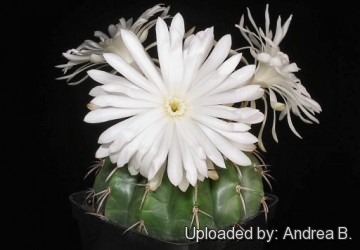 Discocactus crystallophilus Photo by: Andrea B.
Discocactus crystallophilus Photo by: Andrea B. Discocactus crystallophilus Photo by: Cactus Art
Discocactus crystallophilus Photo by: Cactus Art Discocactus crystallophilus Photo by: Valentino Vallicelli
Discocactus crystallophilus Photo by: Valentino Vallicelli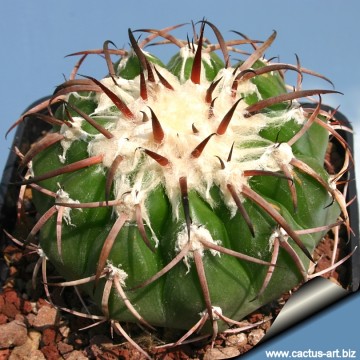 Discocactus crystallophilus Photo by: Cactus Art
Discocactus crystallophilus Photo by: Cactus Art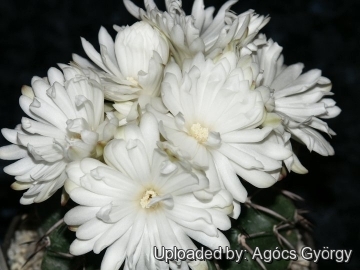 HU 659 (Collector Leopoldo Horst) Senhora da Gloria, Minas Gerais, Brazil at Rebutialand cactus collection Demjén, Hungary. Photo by: Agócs György
HU 659 (Collector Leopoldo Horst) Senhora da Gloria, Minas Gerais, Brazil at Rebutialand cactus collection Demjén, Hungary. Photo by: Agócs György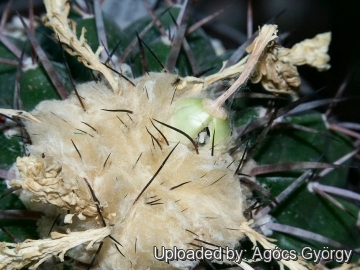 HU 659 (Collector Leopoldo Horst) Senhora da Gloria, Minas Gerais, Brazil at Rebutialand cactus collection Demjén, Hungary. Photo by: Agócs György
HU 659 (Collector Leopoldo Horst) Senhora da Gloria, Minas Gerais, Brazil at Rebutialand cactus collection Demjén, Hungary. Photo by: Agócs György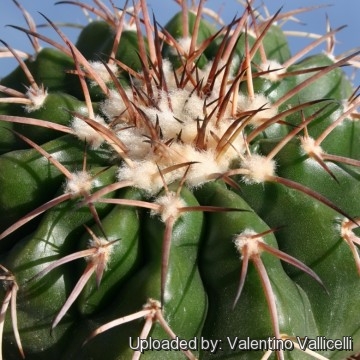 Discocactus crystallophilus Photo by: Valentino Vallicelli
Discocactus crystallophilus Photo by: Valentino VallicelliCultivation and Propagation: Collectors consider this cactus genus from South America to be rarities as they are not the easiest plant to keep happy. it is rather difficult to grow and frost tender, should be kept at above 15° C if grown on its own roots (8°C if grafted) need full sun or afternoon shade. Young seedlings are generally grafted because they are slow growing and very rot prone when kept on their own roots and though they can’t endure long stretches of total dryness, too much water will rot them, as their weak root systems tend to be inefficient at sucking up water from wet soil. They generally resent being repotted and can take a long time to establish.
Propagation: Seed. Young seedlings are often grafted on a low stock to keep the plant in a good shape.
Your Photos

by Cactus Art

by Valentino Vallicelli





















